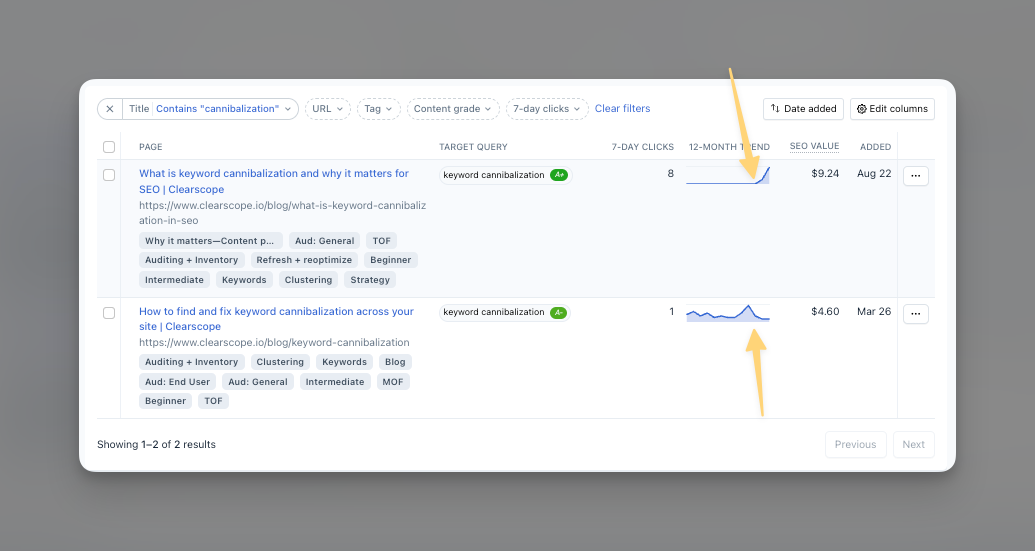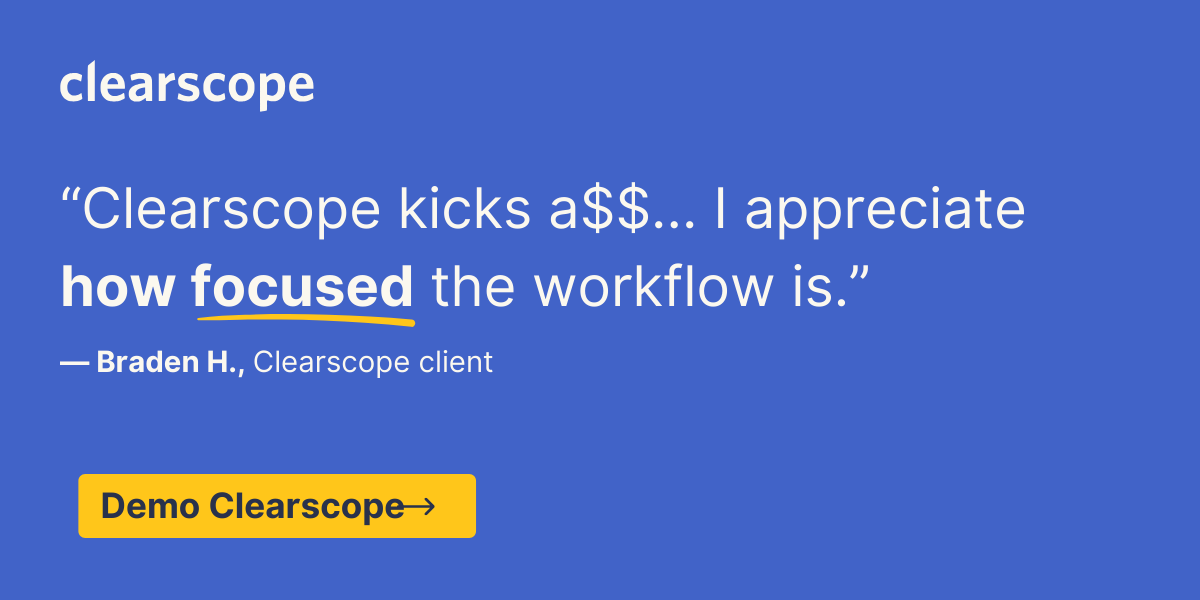How to Avoid Keyword Cannibalization for Good
Topic: SEO
Published:
Written by: Bernard Huang
Keyword cannibalization is a common—but often overlooked—SEO issue that can seriously impact your search engine rankings and overall SEO efforts.
You can have a sparkling, orderly website with perfectly streamlined canonical tags, healthy organic backlinks, organized and categorized product pages, and unique search queries targeted on different pages, and still have cannibalization come after your organic traffic and keyword rankings.
(Ask me how I know: I learned the hard way.)
Even my best content creation efforts that prioritized sharply meeting search intent and EEAT guidelines, incorporating information gain, and creating a good user experience, have experienced cannibalized keywords and duplicate content issues.
I experienced this phenomenon for two clients in the past and with a recent SEO content test I launched here at Clearscope, and it has nothing to do with keyword stuffing or a poor internal linking structure.
When you start ramping up SEO content production for a new client, it almost feels that having pages ranking for similar keywords and stealing traffic from one another is par for the course—if you don’t keep a careful eye on what pages rank for which search intents. (For beginners and experienced SEOs alike.)
But it doesn’t have to be par for the course.
You definitely don’t want Google sending people to the wrong page, just because it believes it should be ranking for a query that you have other, similar pages already targeting.
Once you find and fix keyword cannibalization within your content library, there are a few things you can do to proactively reduce or avoid keyword cannibalization for good.
5 healthy practices to avoid keyword cannibalization in your future content
Inquiring minds on the r/TechSEO subreddit want to know: How do you avoid this issue entirely?
Well, SEO community, I’m glad you asked:
Keep a running list of cornerstone content, or your most authoritative pages for particular topics.
Do a quick check for existing related content during your keyword research phase for new web pages.
Make sure to analyze your target keywords for true, actual search intent to avoid duplicate pages going after the same intents. (Examples of this below.)
Address potential similar content proactively before you publish the new page.
Use internal links, noindex tags, and anchor text wisely and carefully.
Let’s look at each of these healthy digital marketing and SEO practices more closely.
1. Keep a running list of cornerstone content pieces
Maintain an active list of cornerstone content pages and the search terms they’re optimized for.
To build this list out, keep an inventory of your pages with their top ranking queries according to your Google Search Console (GSC) data.
Check new ideas against this list as part of your keyword research before you create content briefs to avoid building cannibal pages.
LEARN MORE: How to do content pruning to boost SEO performance
2. Check existing content during keyword research
If you’re writing a new article on a given keyword, such as [on-page SEO], do a site search before you create the content brief to avoid future cases of keyword cannibalization.
Search site:yourdomain.com [on-page SEO] to find similar pages that may be too competitive or could be competing pages.
You can also use Clearscope’s Position Tracking feature—or traditional keyword research tools like Ahrefs or Semrush.
3. Analyze keyword search intent
To avoid creating future keyword cannibalization problems, look at competitive articles within your existing ranking pages and see if there’s an overlap in user intent.
If so, you may want to pause before you create a new piece of content that’s going to compete with existing articles for similar sets of keywords.
It’s one thing to target keywords on a single page, but understanding and optimizing content for a target user intent (or search intent) is where it’s at.
READ MORE: Beyond the basics: Exploring expanded types of search intent for SEO mastery
A real-world example
For example, let’s look at two pieces of content from Clearscope’s own library that were competing for the same search intent, although they were originally built to optimize for different keywords:
Article 1: What is keyword cannibalization and why it matters for search engine optimization
Article 2: How to find and fix keyword cannibalization issues
Stick with me here—this example is a good one, although it gets a little bit tricky because, ironically, it deals directly with the topic you’re reading about right now.

In Clearscope, you can use the 12-month trend graph to easily spot pages in a topic cluster that might be cannibalizing each other's traffic.
Article 1 was created for beginners—and the keyword strategy for this particular page targeted appropriate, relevant keywords accordingly. Search queries like [what is keyword cannibalization] and [why is keyword cannibalization bad for SEO] are ideal search intents for this particular page.
Article 2 was developed to give guidance on how to fix cannibalization issues that can affect your organic visibility, CTR, and broader SEO or content strategy long-term. The targeted search queries for this page are [how to identify keyword cannibalization] and [how to fix keyword cannibalization].
However, a quick search of the SERPs (search engine results pages) shows signs of keyword cannibalization for the specific keyword [keyword cannibalization].
Yikes.
As funny as this is to have an SEO software company experience actual cannibalization for, ahem, [seo keyword cannibalization], it’s a real problem.
These are both relevant pages in this topic, but they are intended for different query intents and are stealing traffic from one another.
There’s no preferred page in this instance. Instead, these pages need to be re-optimized for sharper, more targeted search intents.
Here’s how I’m going to resolve this issue:
Article 1: I’m going to leave Article 1 as-is for now, as it’s newly published and has an excellent content quality grade in Clearscope, indicating it is targeting search intent correctly.
Article 2: This article hasn’t been refreshed since 2023, and it’s time to rework it. I’m going to use Clearscope to re-optimize the page for a sharper, less generic search intent, going after the query [how to fix keyword cannibalization]. I’m also going to use a Ranch-Style SEO approach to this in-depth main page that previously used a skyscraper SEO tactic, and update it for how SEO actually works today. I’ll focus on improving conversion rates by demonstrating how Clearscope makes content inventory management so much easier. (Because it does! I know I’m biased, but hey, I was using Clearscope years before I joined the team. And it rocks.)
With those changes, and a few internal link building updates to repair the anchor text used to direct people to this page, it should be good to go.

4. Address potential keyword cannibalization issues
If you identify the potential for cannibalization issues, here are some ways you can change up your strategy.
Target a different user intent. You only want to use this for keywords that show multiple user intent opportunities, like the real-world case outlined above. Here’s another example: If you have a page already targeting [webinar for experienced content marketers], you might create one that targets a separate intent in that related topic, like [webinars for new content marketers].
Change your primary keyword. Look for relevant long-tail keywords that won’t compete with the original. For instance, if you already have pieces ranking for [on-page SEO], you can change your content brief to target [on-page SEO for e-commerce websites].
Delete the existing article. If the existing piece has been around for a few years and contains outdated information, you might be better off deleting it and creating a new page. If you do this, simply redirect the old article to your new one. However, if Google Analytics metrics shows the page in question gets regular visits outside of organic search (possibly the marketing team uses it on social media or to direct PPC ads to), you can simply noindex tag the page.
Update the existing blog. In some cases, you may decide to scrap the new piece altogether and focus on re-optimizing the existing page by adding or updating the information. Case studies show that refreshing old high-quality content is almost always a good move.
Ensure you’re not using similar FAQs or headers to existing content. If you are going to move forward with creating the content, make sure you aren’t including a common FAQ or a repeat header on the new page. Distinguish these pages from one another. And if you can’t? Well, then you shouldn’t be creating it.
5. Use technical SEO tactics to properly guide search engines
I’ve talked a lot about content, but technical SEO practices play a critical role in avoiding future keyword cannibalization by ensuring your site’s structure and internal links are properly optimized.
A thorough content audit can help identify important pages that may be competing for the same keywords, like a category page, article, and a landing page.
But you may need to look a little closer: What anchor text are you using throughout your site for that particular article? Make sure it captures what queries you’d like each specific page to rank for.
You should also use canonicalization effectively to guide search engines to the right content—that way, pages that cover similar topics won’t compete with each other and result in lower rankings.

How Chima Mmeje Uses Keyword Clustering To Generate Growth
Learn how content marketing manager Chima Mmeje uses keyword clustering to better organize and prioritize content efforts and generate explosive growth.
Read moreHow to Implement Ranch-Style SEO: 7 Successful Frameworks
Learn 7 successful content frameworks for Ranch-Style SEO, the future-proof, perspective-driven SEO strategy that’ll take your site into the next era of search.
Read moreHow to Find and Fix Keyword Cannibalization Across Your Site
Learn how to fix keyword cannibalization across your site in this step-by-step guide. Resolve the issue of pages or articles on your website that are competing with one another for the same target keyword and user intent.
Read more